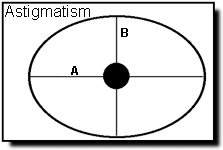Astigmatism
 Many patients with myopia
have some degree of astigmatism, or ovalness to their corneas.
It is the most common refractive condition, and occurs to some extent in most eyes.
Astigmatism occurs when the cornea is shaped more like a football/rugby ball than a
basketball. With astigmatism, different parts of the cornea have different focusing
powers. In the diagram to the left this is shown by lines A and B having different length.
As a result, patients with astigmatism experience distortion or tilting of images because
of unequal bending of light rays entering the eye. Patients with high degrees of
astigmatism have blurred vision not only for distant objects, as with myopia, but for near
objects as well.
Many patients with myopia
have some degree of astigmatism, or ovalness to their corneas.
It is the most common refractive condition, and occurs to some extent in most eyes.
Astigmatism occurs when the cornea is shaped more like a football/rugby ball than a
basketball. With astigmatism, different parts of the cornea have different focusing
powers. In the diagram to the left this is shown by lines A and B having different length.
As a result, patients with astigmatism experience distortion or tilting of images because
of unequal bending of light rays entering the eye. Patients with high degrees of
astigmatism have blurred vision not only for distant objects, as with myopia, but for near
objects as well.
Astigmatism is also measured in diopters. Of all myopic people, 50% or more have astigmatism as well. Most of these people have corrections of less than 1 diopter. The table below shows the categories of severity for astigmatism:
| Mild Astigmatism | less than 1.00 diopters |
| Moderate Astigmatism | 1.00 to 2.00 diopters |
| Severe Astigmatism | 2.00 to 3.00 diopters |
| Extreme Astigmatism | greater than 3.00 diopters |